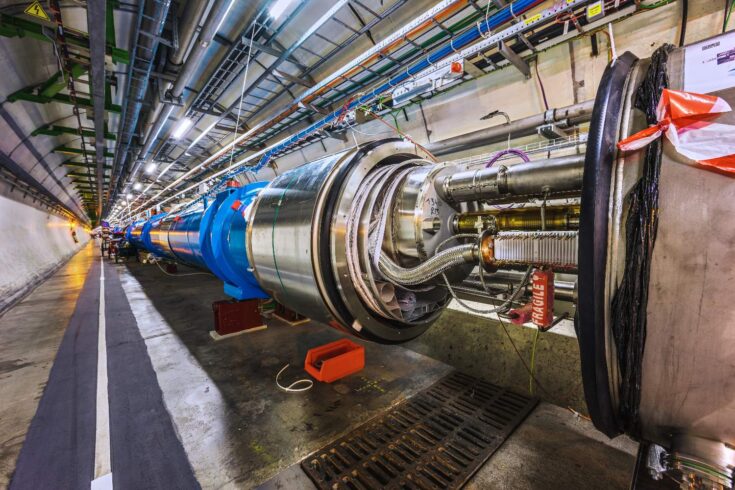Science and Technology Facilities Council
|
|
Large Hadron Collider takes first data in record-breaking run
The world’s most powerful particle accelerator is ready to start delivering proton collisions to experiments at a record-breaking energy level.

Large Hadron Collider tunnel during long shutdown two. Credit: Brice, Maximilien, CERN
Scientists and engineers in the UK have helped the Large Hadron Collider (LHC) achieve unprecedented energy of 13.6 tera electron volts (TeV).
This marks the start of the accelerator’s third run of data taking for physics at CERN, on the French-Swiss border near Geneva.
The science starts
The beam began circulating in April, after more than three years of upgrades and maintenance work to make it even more powerful.
The LHC machine and its injectors had previously been recommissioned to operate with new higher-intensity beams and increased energy.
Beam operators have now announced the beam is stable and ready to start taking data to be used for science.
The LHC will now run around the clock for close to 4 years at the record energy of 13.6 TeV.
The role of the UK
As part of the international effort, UK teams have led a series of vital work packages to improve the performance of each of the LHC’s four main instruments. They have also worked on the beam itself.
The UK’s contributions to the upgrade are worth more than £25 million, funded by the Science and Technology Facilities Council (STFC).
Physics beyond our current understanding
Professor Mark Thomson, STFC Executive Chair and particle physicist, recently said:
The hard work of many highly-skilled scientists and engineers in the UK has been vital to get to this point.
Today’s news is just the beginning of an exciting few years, as physicists at CERN harness the power of the upgraded machine and vast detectors to push the frontiers of knowledge.
Time will tell whether the LHC and its detectors, with their improved capabilities, can provide a first glimpse of physics beyond our current understanding.
Major upgrades
The four big LHC experiments have performed major upgrades to their data readout and selection systems, with new detector systems and computing infrastructure.
The changes will allow them to collect significantly larger data samples, with data of higher quality than in previous runs.
The ATLAS and CMS detectors expect to record more collisions during run three than in the two previous physics runs combined.
The Large Hadron Collider beauty experiment underwent a complete revamp and looks to increase its data taking rate by a factor of 10. At the same time, ALICE is aiming at a staggering fifty-time increase in the number of recorded collisions.
What’s next for the LHC?
With the increased data samples and higher collision energy, run three will further expand the already very diverse LHC physics programme.
Thanks to the UK’s subscription to CERN, managed through STFC, UK physicists will have the chance to:
- use the LHC to try to address fundamental questions, such as the origin of the matter-antimatter asymmetry in the universe
- study the properties of matter under extreme temperature and density.
Scientists will also be searching for candidates for dark matter and for other new phenomena, either through direct searches or indirectly through precise measurements of properties of known particles.
Fate of our universe
Professor Sinead Farrington from the University of Edinburgh is the UK spokesperson for the ATLAS experiment. She recently said:
This moment of reawakening the LHC accelerator and experiments to deliver data at a higher collision energy than ever before is an exhilarating time to be a particle physicist.
The past three years of preparations will allow us to explore uncharted and rare interaction regimes.
What will the constituent particles of the protons do when they interact with higher energies than ever before? It’s ten years since we discovered the Higgs boson but we’ve only recorded 10% of the data that the LHC will deliver.
Will the holy-grail double-Higgs production occur in the expected way? What is dark matter? Why is the universe matter-dominated?
The experiments are ready and waiting to probe these questions so that the LHC can uncover the nature and perhaps ultimately the fate of our universe.
For more information on UK’s involvement in the LHC upgrade, please read the news story on the UKRI site.
Further information
In addition to the four large LHC experiments, several novel smaller experiments were built and installed during the long shutdown. They are excited to see their very first data as run three starts.
FASER
The new ForwArd Search ExpeRiment (FASER), located 480 meters from the ATLAS detector, is one of these brand new experiments.
It was built to search for the decays of hypothesised new particles with a long lifetime produced in LHC collisions, that are candidates for dark matter.
It will search for them in regions never previously explored even with the data taken this year and UK physicists are playing a leading role.
Original article link: https://www.ukri.org/news/large-hadron-collider-takes-first-data-in-record-breaking-run/


.gif)